In the October issue of Backcountry Magazine, ski mountaineer Kit DesLauriers reported on her trip with freeride skiers Crystal Wright and Keely Kelleher to ski lines rumored to be first descents in a remote corner of Spain’s Pyrenees in the Catalan region of Parc Nacional d’Aigüestortes Estany de Sant Maurici. Along for the journey was photographer and ski mountaineer Fredrik Marmsater who captured the journey on film.
To learn more about the journey from the other side of the lens, we caught up with Marmsater to talk about his experience and what images resonated with him. Here are his photos and reflections on the trip.
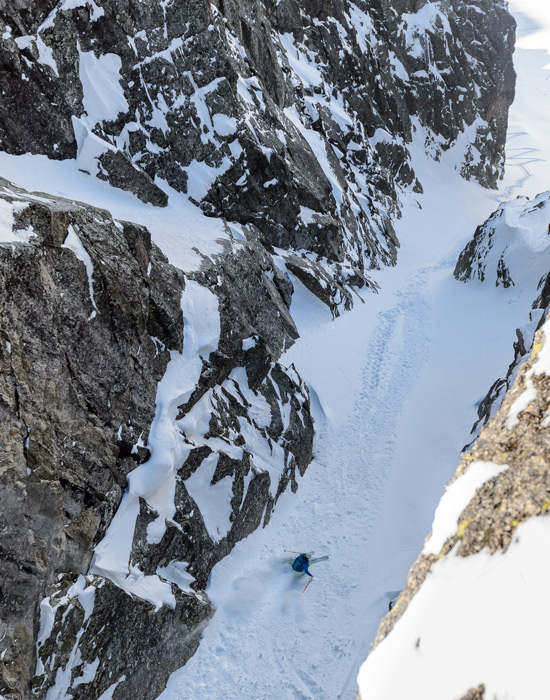
Crystal Wright skis Canal de las Novias on Punta Estasen.
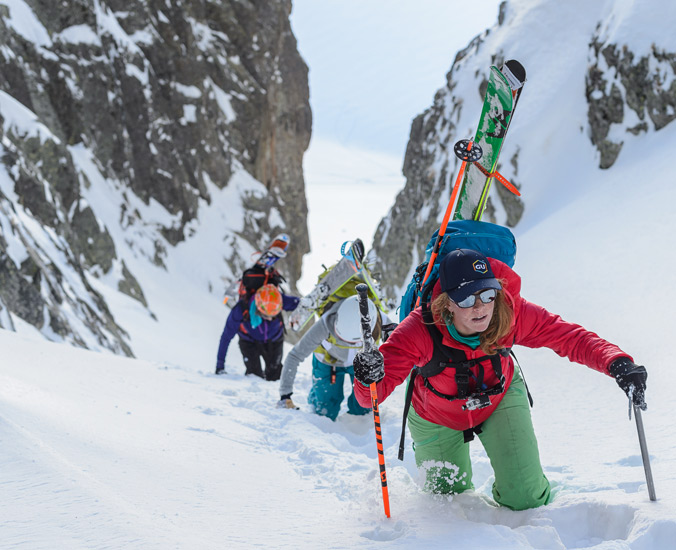
Crystal Wright, Keely Kelleher and Kit DesLauriers boot up Canal de las Novias on Punta Estasen.
Kit and Crystal had told me that they didn’t think that many people had skied in the Pyrenees, but it’s Europe, so I was like, “Yea right, sure, everything has been skied and skied a long time ago.” But as we were cruising around, it felt as though that was true.
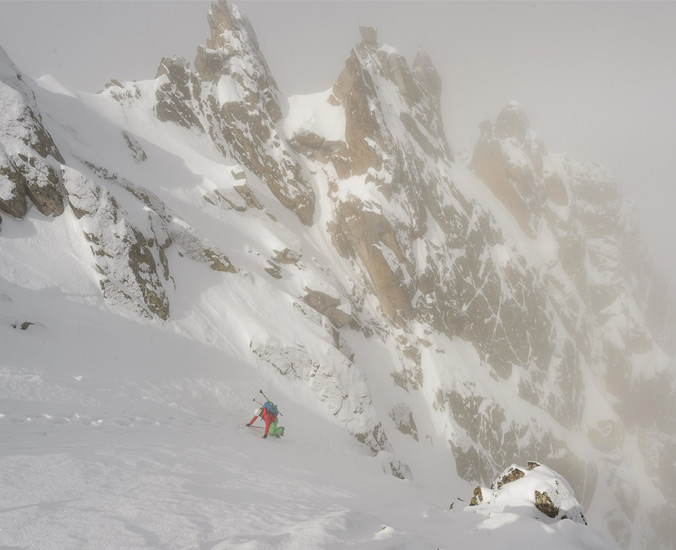
Crystal Wright tops out on Del Portarro Inferior, directly across the valley from Amitges hut.
We saw other people cruising around from hut to hut but nobody was skiing. They were just Nordic touring or snowshoeing and going hut to hut. We thought, “Wow, there are all these lines, and nobody is touching them.”

Keely Kelleher, Kit Deslauriers and Crystal Wright hang out with the Refugi D’Amitges hut keeper Roc Sagrista.
The infrastructure of the huts is amazing. All of the hutkeepers that we met were young and psyched that we were there checking things out. They were giving us great beta. It was the absolute opposite of what you experience almost anywhere else. They would tell us where to ski, even direct us towards first descents (we did not actually accomplish any first descents).
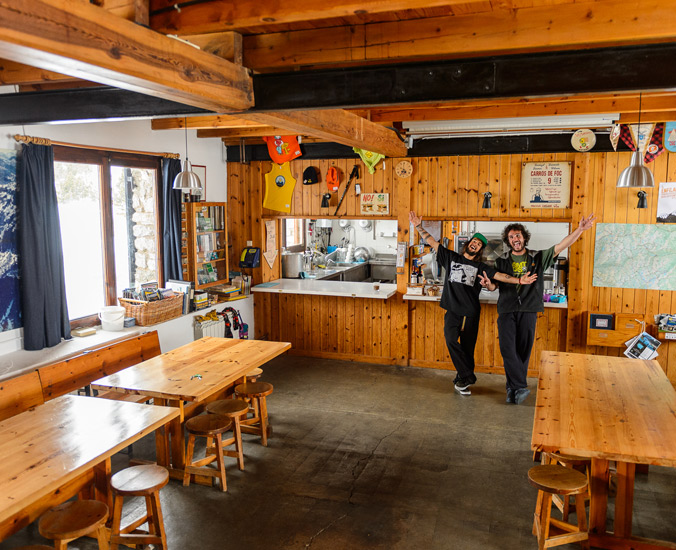
Hutkeepers welcome us to Refugi d’Amitges.
The locals are amazing. We shredded with [a guide for Val’Daran], David Sanabria, who’s a local guide who came out and skied with us for a couple days. One of the local avalanche educators, Eduardo Gonzalez came too, and they showed us around some of their favorite lines.

Val d’Aran local and guide, David Sanabria.
We skied what you could equate to the Grand Teton of the region, which is the Canal de Central of Gran Encantat. It is the couloir on the opening spread of the story in the October Issue. It is an epic line; long, steep and continuous with a demanding approach. David took us around this mountain, up over the summit and then down into the couloir which requires a bunch of rope work and some pretty sketchy exposed climbing. And in classic Catalan style, we started casually around noon. So, we started off with a good adventure.

Twin summits of Gran Encantat, with the Canal de Central. We summited the lookers-right peak, and downclimbed and rappelled into the notch, skied the line and rapped through the cliff band onto the lower apron. Photo taken form the deck at Refugi d’Amitges.
You can see the twin summits in the opening spread—we came down the summit on the lookers right. We rapped down from the ridge and then down climbed the last snow ramp, then entered the line. It had Keely and Crystal pretty fired up. Crystal and Keely were on their toes. I know I was on my toes.
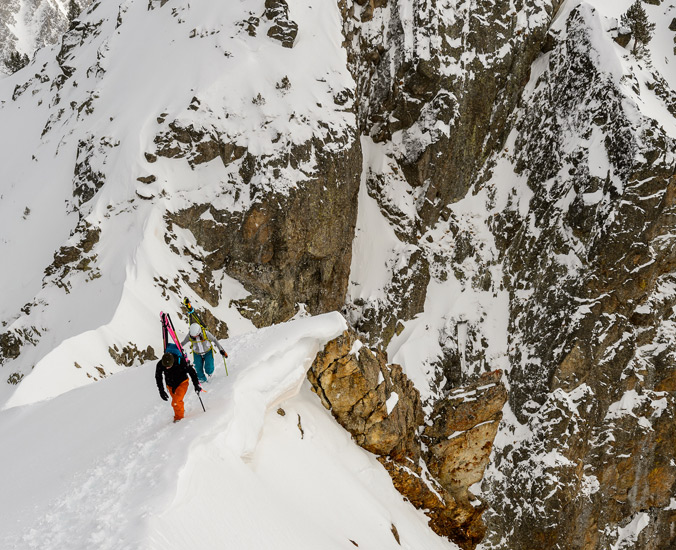
David Sanabria and Keely Kelleher climb the north ridge of Gran Encantat, en route to skiing the Canal de Central.
David had to get the rope out, and I certainly wasn’t expecting it to be that intense. It got dark, and I had to put my energy into getting the team down the mountain instead of shooting photos, so I didn’t actually shoot that much on the actual skiing of that line, which I really regret now—even though it was pitch black.
Once we had the team at the saddle on top of the ski line, David was like, “Oh yea, the rap anchor is down there on the left.” So Ed and I bombed down the line to set up the rap, so we could get out of there. But this line was steep, long and continuous, and there was a slight curve in it, so you didn’t really ever see your fall line—it just kind of curved and rolled over to the right and into the darkness. I didn’t really know where the cliff was; I didn’t really know what was below me, so when I reached some cliffs, I down-climbed. I kicked around, and I couldn’t find the anchor, I couldn’t find anything. So I backtracked and tried to come back up the run. But David started skiing down and he sluffed all this snow on top of me, so I was getting pounded and just hanging on by my edges on rock. And then he said, “Oh yea, the anchor is right here!” and it was on the right and above the rocks that I had skied through. If he had told me it was on the right, I would not have even been down there. And that was just language barrier stuff, which actually made it just that much more interesting. David and Eduardo spoke good English, but I still got kind of lost.
We didn’t get back to the hut until late, and you drop down into a valley before you get to the hut so you have to skin around 2,000 vertical feet back up to the hut. I think most people were out of food and water. Crystal and I put our heads down and motored up to the hut. And of course David and Ed were typical Catalan guys and just cruised up the skintrack at a super mellow pace, shooting the shit the whole time. They showed up an hour later, happy as clams. They had the most chill, laid-back attitude. They just roll that way. That was by far our best day, and I think one of my favorite images from the whole trip is the image of Crystal on the top of that ridge, which is on the second-to-last page.
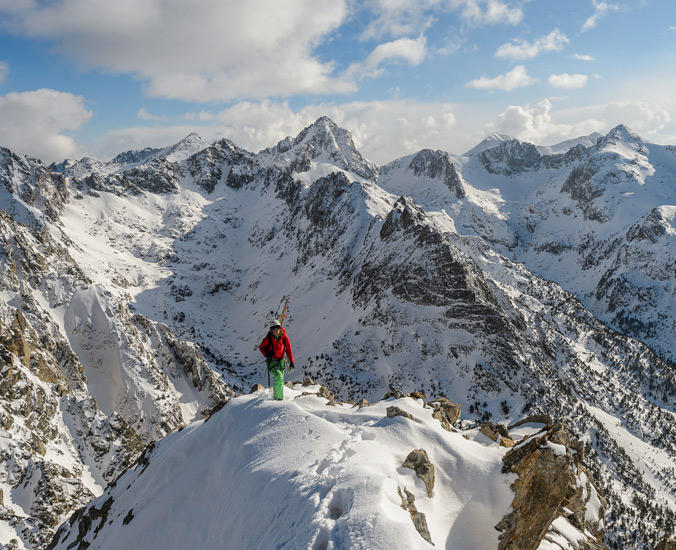
Crystal Wright tops out on the exposed ridge of Gran Encantat.
All the people we met were amazing people. What’s really cool about the Pyrenees is that you have this beautiful place and these amazing people and personalities with really great mountains and good food. It is really affordable—it’s just so laid back, and there is so much skiing. The skiing ranges from pretty mellow touring to gnarly stuff like Canal de Central. Most of the stuff we skied except for that one line were 1000- to 1500-foot lines.
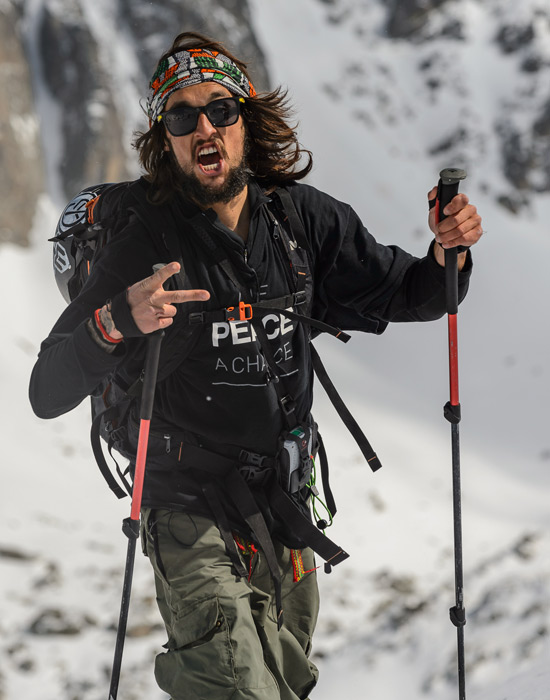
Roc Sagrista, the heart and soul of Refugi d’Amitges.
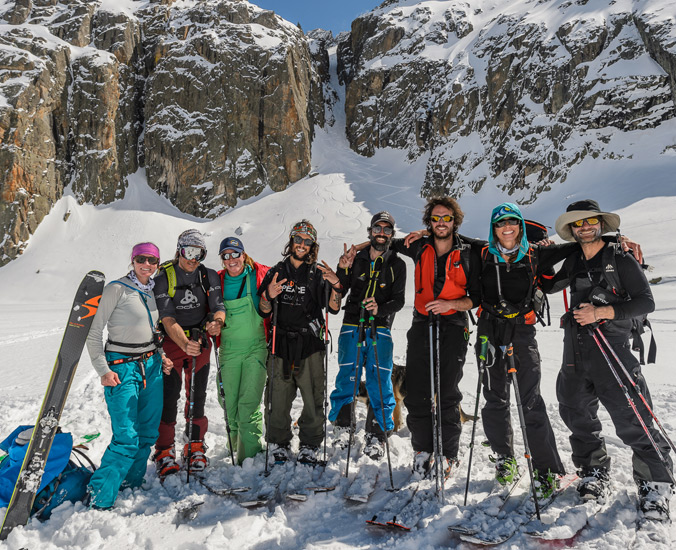
The girls hangin’ with the local crew at the bottom of Canal de las Novias on Punta Estasen. These guys hung at the bottom and cheered our group as the girls shredded the line.
You could come there as a pretty inexperienced—or maybe more accurately—not a hardcore ski mountaineer or freeskier type—someone that just loves to ski tour, hire David to guide your group, and you would have an awesome time. It was one of those trips where I was like, “Wow, I can’t believe I have never been here. I can’t believe I have never even really heard about this particular region.” I still don’t really believe that most of the stuff hasn’t been skied. But you could certainly go there and have an experience that is much more wilderness-feeling that most other areas in the Alps. But at the same time you have this amazing hut infrastructure. You can get out there and generally not see that many people, especially when you get off the hut-to-hut routes, which are just banged in skin tracks or snowshoe tracks. You get off that path and ski a different route, or peak, or some couloirs and you aren’t going to see anyone. The only people skiing that stuff are the hutkeepers.

Keely Kelleher makes turns in the Canal de las Novias on Punta Estasen.
—
To get a copy of the October Issue, visit backcountrymagazine.com/subscribe. Visit Fredrik Marmsater’s website at www.fredrikmarmsater.com.











Was Julian Sanllehy still the hutkeeper at the Refugio Saboredo?
Yes, he’s still hutkeeper. Great hut to visit
Beautiful pics! Can’t believe there are still parts unknown and untouched.